BIO-C11—Cell Reproduction–2
1/73
Earn XP
Description and Tags
Cell Cycle Regulation and Cancer
Name | Mastery | Learn | Test | Matching | Spaced |
|---|
No study sessions yet.
74 Terms
Why is the cell cycle controlled by checkpoints?
To ensure that a previous phase is fully completed before advancing to the next phase.
During cell regulation and replication, what does “feedback” from the cell refer to?
Determines whether the cycle switches to the next stage.
Three principal checkpoints control the cycle in eukaryotes:
G1, G2, and M checkpoints.
What happens at the G1 checkpoint?
This checkpoint determines whether the cell should divide and enter S phase.
Some cells never pass this point and are said to be in G0.
What happens at the G2 checkpoint?
This checkpoint leads to mitosis.
What happens at the M checkpoint?
This checkpoint occurs during metaphase and triggers the exit process of the M phase and entry to the G1 phase.
Cancer is?
A growth disorder of cells. It begins when apparently normal cells grow uncontrollably and spread to other parts of the body.
What is a tumour?
The result of a growing cluster of cells.
What is a benign tumour?
Tumours that are surrounded by a healthy layer of cells (also known as encapsulated) and do not spread to other areas.
What is a malignant tumour?
Tumours that are not encapsulated and are invasive.
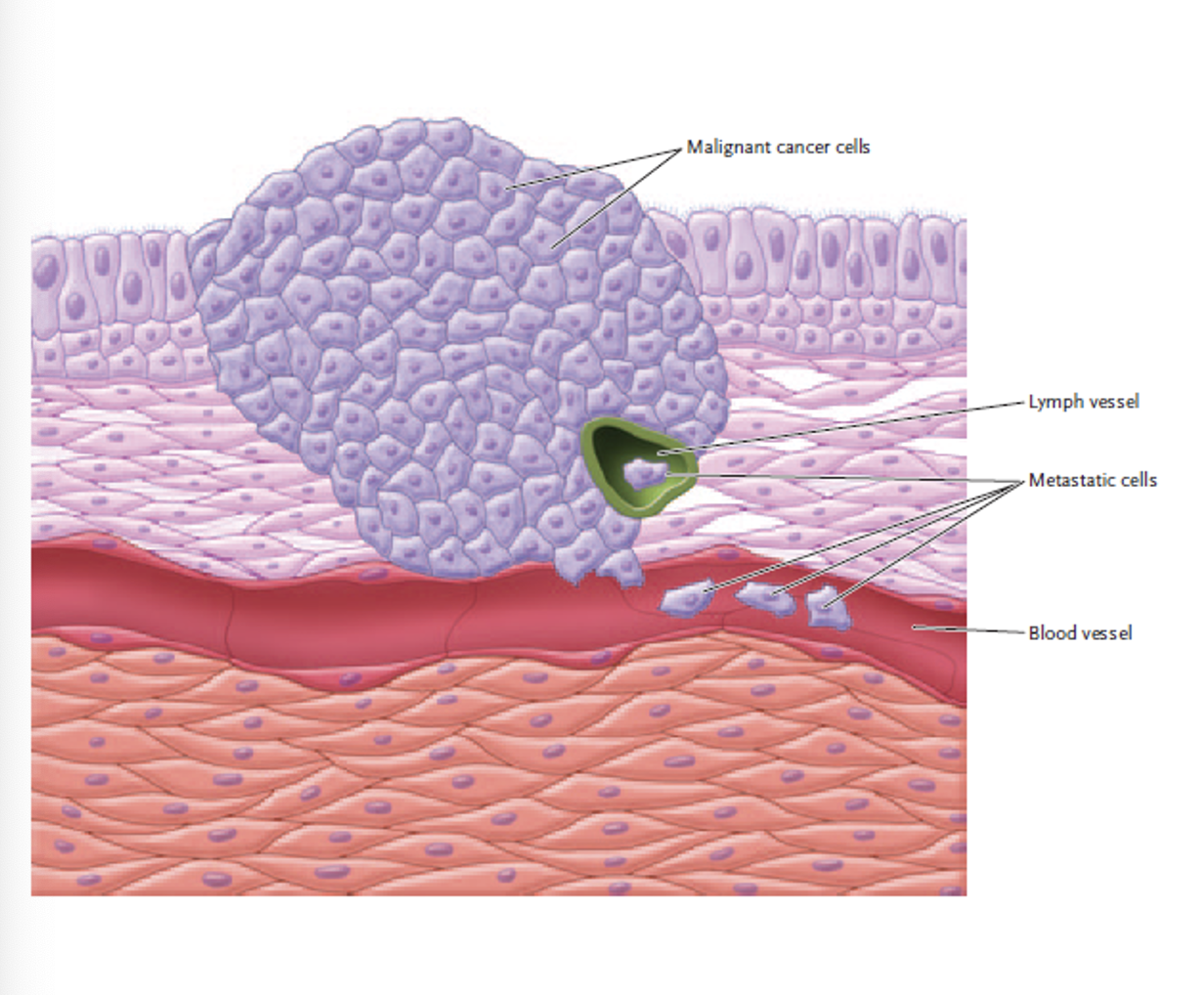
What is metastases?
Cells from malignant tumours leave and spread to different areas of the body to form new tumours.
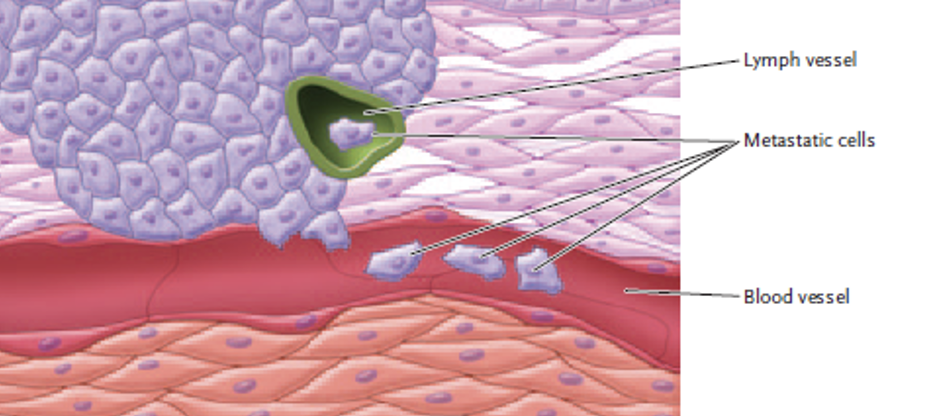
Cancer is caused by?
A gene disorder in somatic tissue in which damaged genes fail to properly control the cell cycle.
What do mutations do to genes?
They damage the genes.
Mutations are a result of?
They may result from chemical or environmental exposure, such as UV rays.
Viral exposure may also..
Alter DNA
What are examples of viral exposure that lead to DNA mutations?
HIV (human immunodeficiency virus)
HPV (human papilloma virus)
What are the two genes classes that are usually involved in cancer?
Proto-oncogenes
Tumour-suppressor genes
What are Proto-oncogenes?
•These genes encode proteins that stimulate cell division.
•Mutations to these genes can cause cells to divide excessively.
•When mutated, these genes become oncogenes.
What are Tumour-suppressor genes?
•These genes normally turn off cell division in healthy cells.
•When mutated, these genes allow uncontrolled cell division.
P53 gene (a tumour suppressor gene that stops the cell cycle at the G1 checkpoint when DNA mutations are detected.
What causes cancer at the cell division/genetic level?
Results from damaged genes failing to control cell division.
What gene plays a key role in controlling the G1 checkpoint?
The p53 gene
What is the normal function of the p53 gene?
It detects abnormal DNA and prevents cell division until the DNA is repaired or directs the cell to self-destruct if the damage can’t be fixed.
What happens if the p53 gene becomes damaged?
Damaged p53 allows cells with abnormal DNA to divide unchecked, leading to cancer.
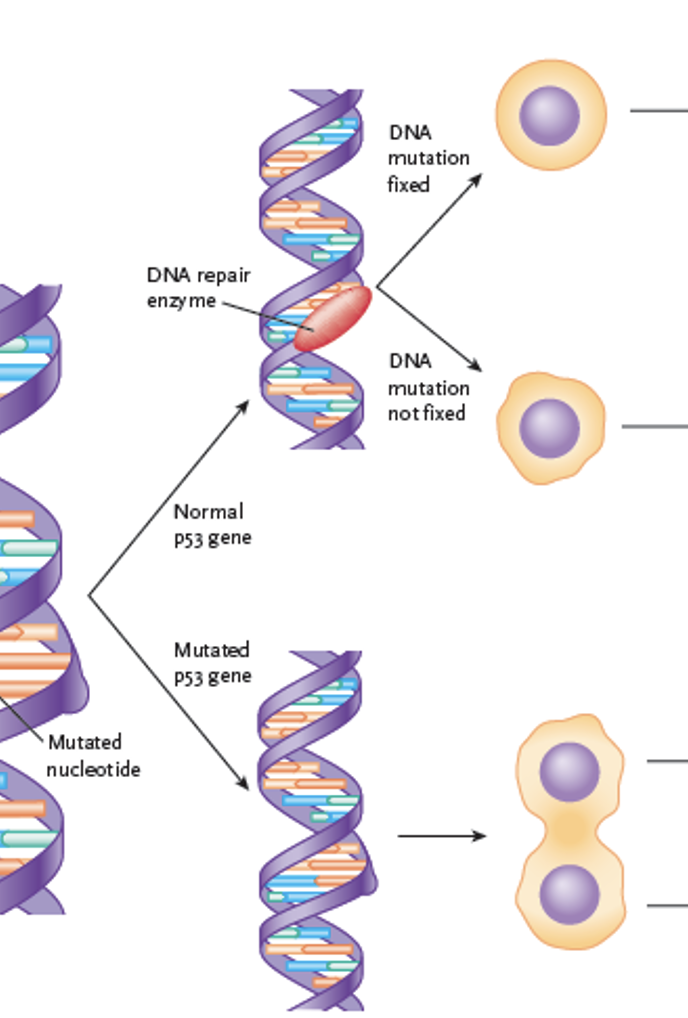
At which stage of the cell cycle does p53 act?
The G1 checkpoint, where the cell decides whether to divide, repair DNA, or undergo apoptosis.
When DNA mutations are detected, what’s the tumour suppressor gene that acts to stop it at the G1 checkpoint?
The P53 gene
If any of the following types of genes are mutated, cancer could develop:
•Genes involved in the regulation of the cell cycle, such as proto-oncogenes and tumour-suppressor genes
•DNA repair enzymes
•Genes that increase angiogenesis
•Genes involved in apoptosis
•Genes that regulate the immune response
What important chemicals are in anti-cancer foods?
Phytochemicals that either regulate our immune response, decrease angiogenesis, or they are antioxidants that prevent free radical molecules from damaging our DNA.
How to phytochemicals help us prevent cancer?
They regulate our immune response, decrease angiogenesis, or they are antioxidants that prevent free radical molecules from damaging our DNA.
What are examples of some anti-cancer foods with phytochemicals?
Vegetables, nuts, seeds, green tea, garlic, turmeric, fish, and berries.
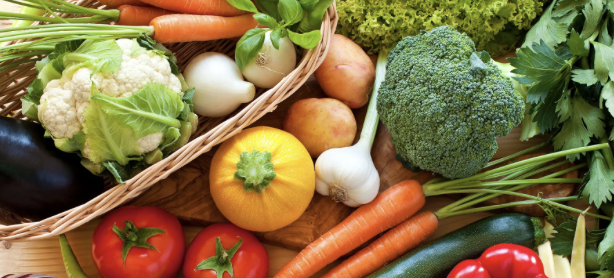
Of all deaths in Canada each year, what percentage of these are due to cancer?
30%
What is the most common cancer in men?
Prostate
What is the most common cancer in women?
Breast
What are the top four types of cancer?
Lung
Prostate
Breast
Colorectal
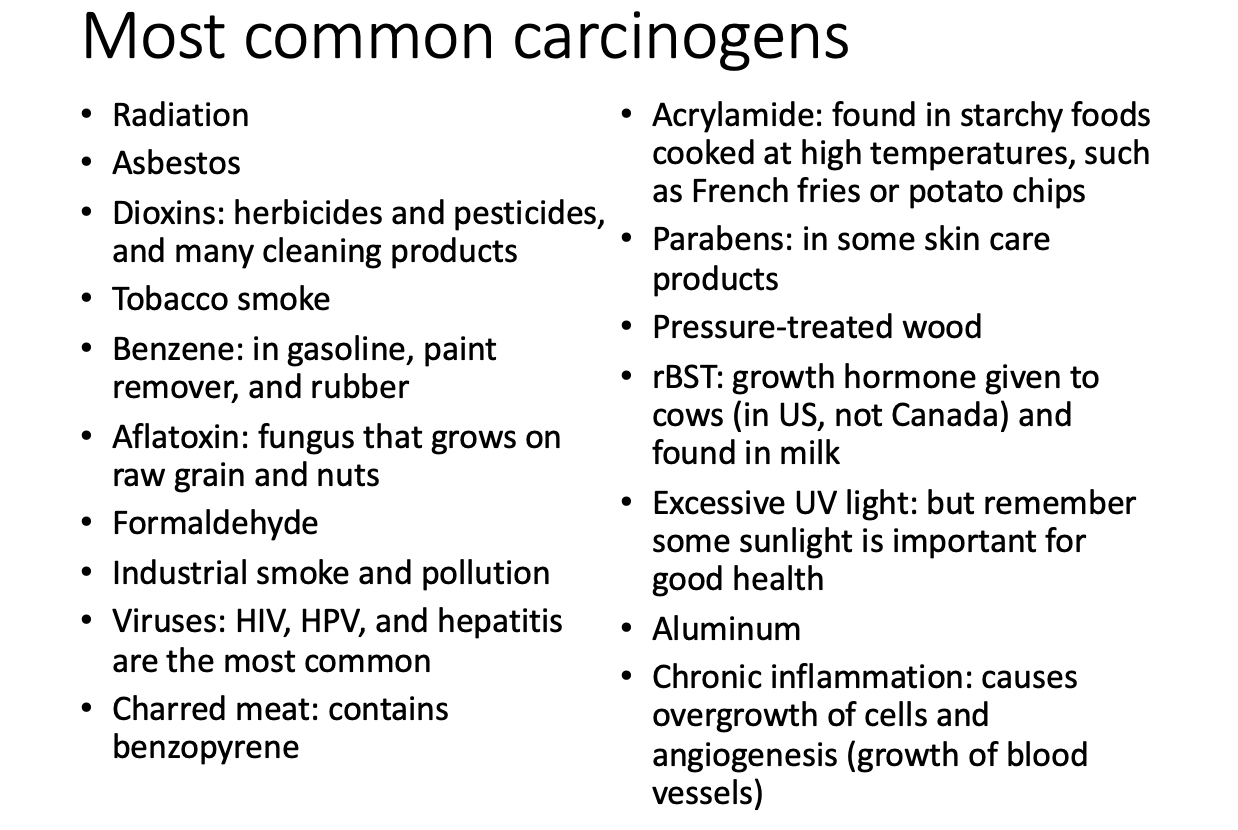
Approximately what percentage of cancer deaths can be prevented by lifestyle changes?
70%
Why does Meiosis occur?
•To produce gametes (sperm or eggs)
•Gametes are haploid cells (have half the normal amount of DNA).
What cells undergo meiosis?
Germ cells in the testes or ovary (in mammals)
What type of cells are gametes?
Haploid cells that combine during fertilization to form a zygote, becoming a diploid cell.
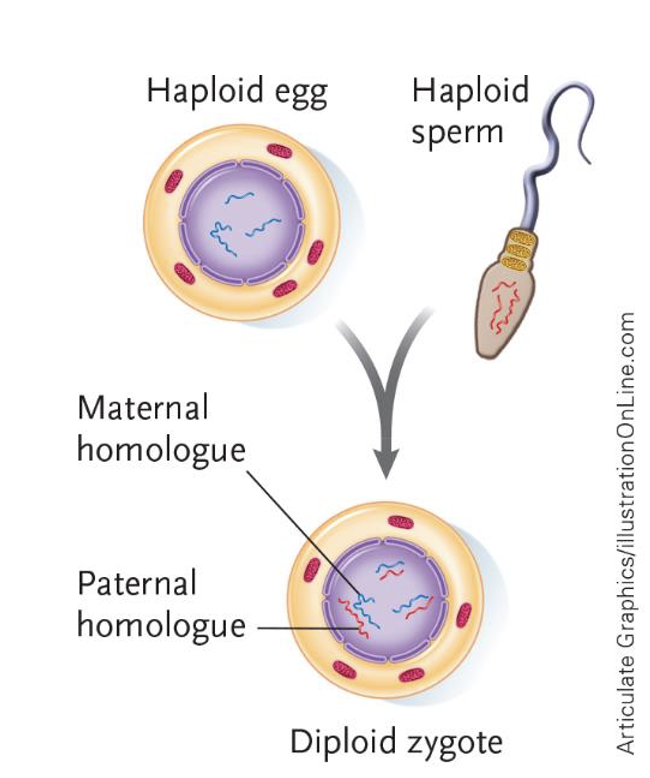
What is the result of meiosis in humans?
Sperm and eggs
How many chromosomes do haploid gametes have?
23 chromosomes, which is half the number of chromosomes in a diploid cell.
How many chromosomes are in a diploid zygote?
46 chromosomes, which is the total number from both parents gamete cells- sperm and egg.
Asexual reproduction is..
No genetic exchange.
Offspring have same DNA as parent
Sexual reproduction is:
Genetic variation, gamete production via meiosis.
All eukaryotic organisms have some version of meiosis and fertilization, resulting in offspring that inherit genetic material from both parents.
How many divisions are involved in meiosis? What are they called?
Two:
Meiosis I
Meiosis II
At what stage of Meiosis is DNA replicated?
DNA is replicated during interphase, specifically in the S phase before Meiosis I begins.
Meiosis I separates the
Homologous chromosomes into two daughter cells. This process reduces the chromosome number by half.
Meiosis II separates the
Sister chromatids into four haploid daughter cells.
When meiosis is complete, the result is that one diploid cell has become one
Haploid egg, or four haploid sperm
Males begin to produce sperm during puberty, and..
This continues throughout the rest of their lives.
How many gametes do males produce?
Millions per day
Females begin to produce eggs…
Before their birth
Meiosis is completed in females only if the egg is..
Fertilized by a sperm.
Meiosis in women is completed….
Only as many times as pregnancy occurs.
Females produce one egg per…
Month. (almost finished meiosis)
[Meiosis I] Prophase I:
Homologues pair up and exchange segments of DNA through a process called crossing over.
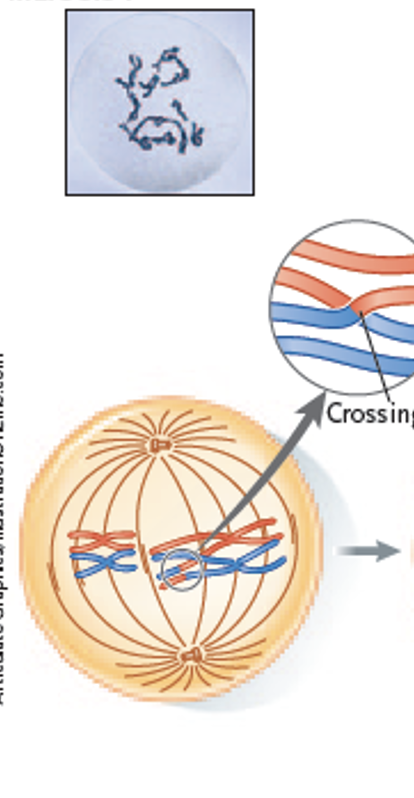
[Meiosis I] Metaphase I:
The paired homologous chromosomes align at the equatorial plane. Spindle fibers attach to the centromeres.
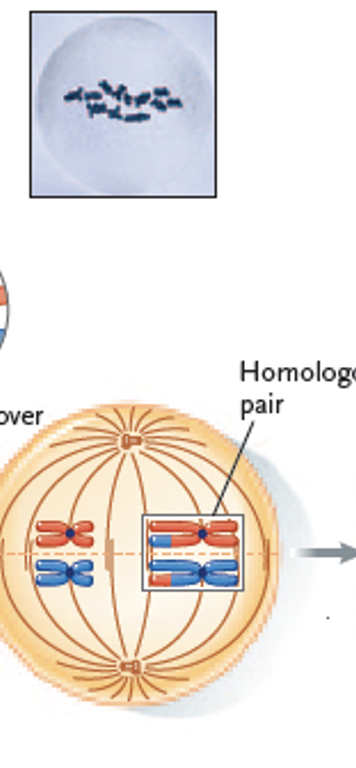
[Meiosis I] Anaphase I:
Homologues separate from the pairing and are pulled to opposite poles of the cell.
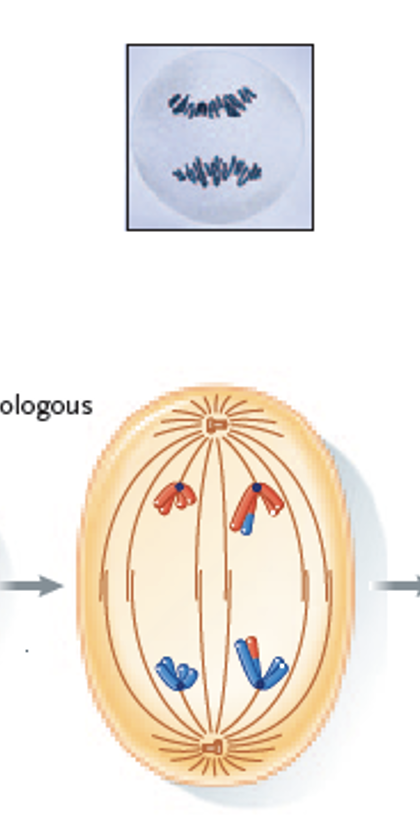
[Meiosis I] Telophase I:
Individual chromosomes gather at each of the two poles.
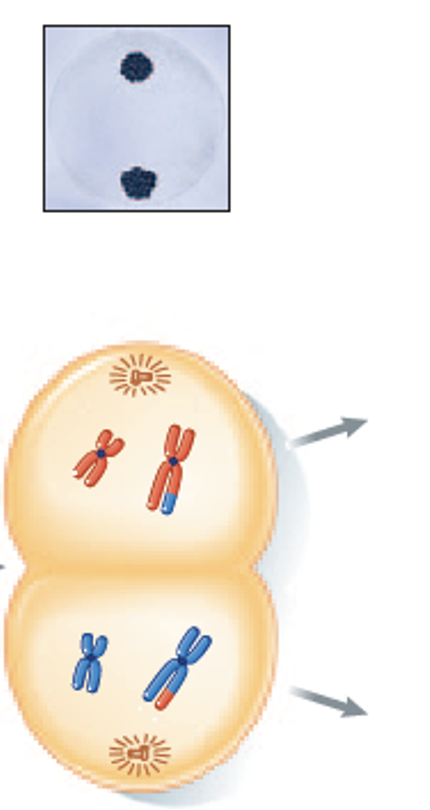
[Meiosis II] Prophase II:
After a brief interphase with no DNA replication, new spindle fibres form.
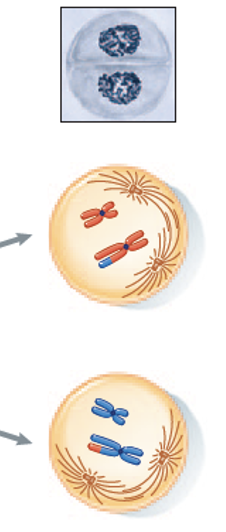
[Meiosis II] Metaphase II:
The sister chromatids align at the equatorial plane.

[Meiosis II] Anaphase II:
Sister chromatids are pulled apart(separate) from the pairing and move to opposite poles. The chromatids, now individual chromosomes, are drawn toward opposite ends of the cell, ensuring each new cell will receive an identical set of chromosomes.
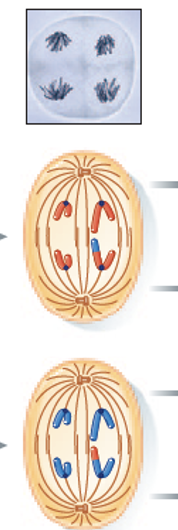
[Meiosis] Telophase II:
Individual chromosomes gather at each of the two poles, and a new nuclear envelope forms.

There are many variations of each gene, called..
Alleles. (variants of a gene)
The gene combinations that we inherit from our parents depend on..
How their genes were sorted during their meiosis process.
Each sperm or egg that you make will always be..
Different. This is why two parents can have many children and they will always have different DNA
•During prophase I, homologous chromosomes..
Line up together as a pair.
Crossing-over occurs during
Prophase I.
This process allows for genetic recombination between homologous chromosomes.
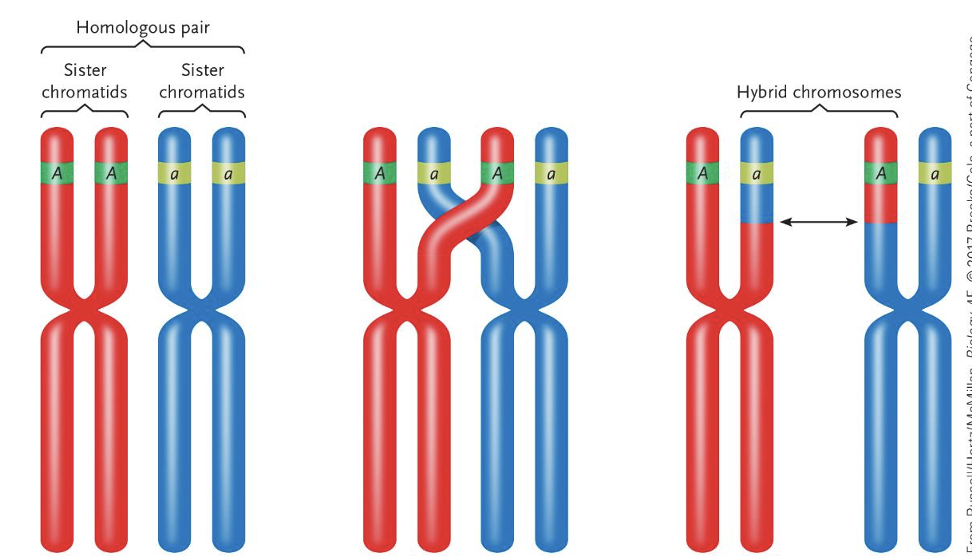
What happens during the crossing-over part of prophase I?
•The chromatids break in the same place and a section of each chromosome is swapped with the other.
•The result is a hybrid chromosome.
The pairing is held together by the cohesin between sister chromatids and the cross-overs.
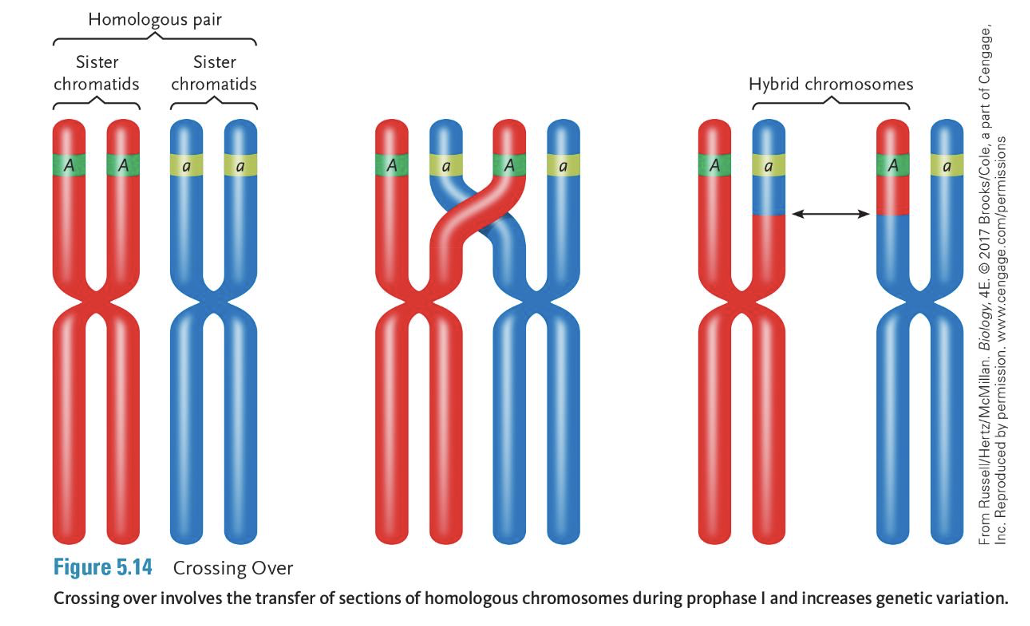
During metaphase I, the orientation of the homologous chromosome pairing is a matter of..
Chance and determines which chromosome is inherited by each daughter cell.
Regarding homologous chromosomes, each possible variation of which homologue faces which pole results in gametes with..
Different combinations of parental chromosomes.
Independent assortment is a process where:
•During metaphase I, the orientation of the homologous chromosome pairing is a matter of chance.
•Regarding homologous chromosomes, each possible variation of which homologue faces which pole results in gametes with different combinations of parental chromosomes.
What two unique features in meiosis are not found in mitosis?
Synapsis – This is the process of drawing together homologous chromosomes down their entire lengths so that crossing over can occur.
Reduction division – Because meiosis involves two nuclear divisions but only one replication of DNA, the final amount of genetic material passed to the gametes is halved.
Sexual reproduction has an enormous impact on how species evolve because it rapidly…
Generates new genetic combinations—genetic variation.
What are the three main mechanisms that help produce genetic variation?
Independent assortment
Crossing over
Random fertilization – one of 8 million different sperm can fertilize the egg.